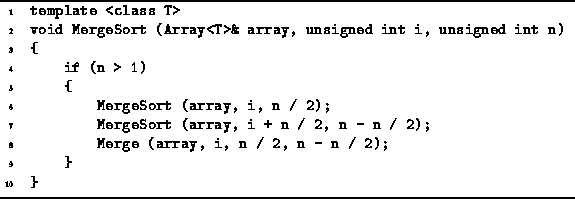Sorting algorithms and sorters are covered in detail in Chapter ![]() .
In this section we consider a divide-and-conquer sorting algorithm--merge sort .
Given an array of n items in arbitrary order,
the objective is to rearrange the elements of the array
so that they are ordered from the smallest element to the largest one.
.
In this section we consider a divide-and-conquer sorting algorithm--merge sort .
Given an array of n items in arbitrary order,
the objective is to rearrange the elements of the array
so that they are ordered from the smallest element to the largest one.
The merge sort algorithm sorts a sequence of length n>1
by splitting it into to subsequences--one of length ![]() ,
the other of length
,
the other of length ![]() .
Each subsequence is sorted and then the two sorted sequences
are merged into one.
.
Each subsequence is sorted and then the two sorted sequences
are merged into one.
Program ![]() defines the function MergeSort which
takes three arguments,
array, i and n.
The routine sorts the following n elements:
defines the function MergeSort which
takes three arguments,
array, i and n.
The routine sorts the following n elements:
![]()
The MergeSort routine calls itself
as well as the Merge routine.
The purpose of the Merge routine is to merge two sorted sequences,
one of length ![]() ,
the other of length
,
the other of length ![]() ,
into a single sorted sequence of length n.
This can easily be done in O(n) time.
(See Program
,
into a single sorted sequence of length n.
This can easily be done in O(n) time.
(See Program ![]() ).
).

Program: Divide-and-Conquer Example--Merge Sorting
The running time of the MergeSort routine
depends on the number of items to be sorted, n.
Although Program ![]() works correctly for arbitrary values of n,
it is much easier to determine the running time
if we assume that n is a power of two.
In this case,
the running time is given by the recurrence
works correctly for arbitrary values of n,
it is much easier to determine the running time
if we assume that n is a power of two.
In this case,
the running time is given by the recurrence
Equation ![]() is easily solved using repeated substitution:
is easily solved using repeated substitution:

Setting ![]() gives
gives ![]() .
.